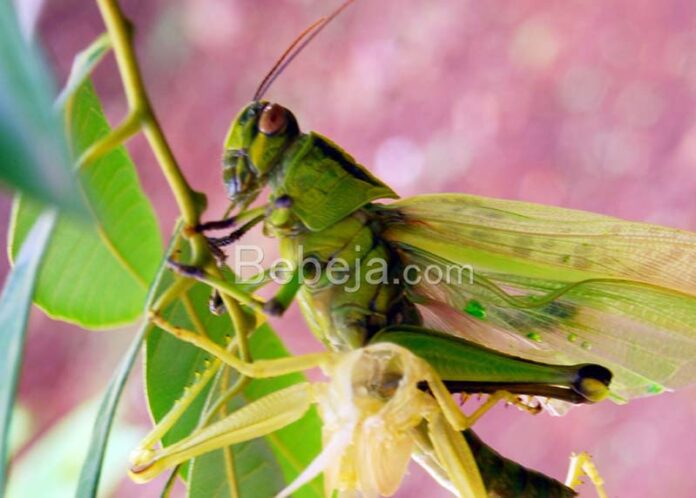Locust pests are a significant concern for farmers, as they can inflict significant economic losses by attacking crops. In Indonesia, several provinces have reported locust attacks, including Bengkulu, South Sumatra, Lampung, South Sulawesi, and Central Kalimantan.
Members of the Orthoptera order have been known to attack a number of agricultural commodities, including rice, corn, sugarcane, and other Gramineae plants. A significant number of locusts become agricultural pests.
A. Migratory Locust (Locusta migratoria)
This member of the Locustidae family is classified as a destructive pest that is highly feared by rice, corn, and sorghum farmers due to its significant destructive potential. The locusts, which are equipped with long and robust legs that enable them to leap considerable distances, consume the stems, leaves, and buds of plants. The potential for losses can reach 100%.
a. Symptoms
Symptoms are not specific, depending on the crop type and population level. Generally, leaves are the main target. Bite marks are irregular jagged tears. In severe infestations, only the leaf bone remains.
b. Causes
The locust population explodes when climate change occurs. High temperatures and low humidity accelerate the growth of locust eggs stored in the soil.
c. Countermeasures
Mechanically carry out mass destruction starting from the egg, and nymph, to imago stadia. Chemical control since nymphs is highly recommended with insecticides Buldok 25 EC made from betasiflutrin, Decis 25 EC made from deltamethrin, Matador 25 EC, Alika 247 ZC made from lamda sihalotrin, or Regent 50 SC made from fipronil. Tillage to a depth of 15 cm to kill the locust eggs.
B. Small Rice Grasshopper (Oxya chinensis and O. velox)
In general, the Oxya genus is known to attack rice plants in rice fields and swamplands. Nevertheless, in certain instances, members of the Acrididae are observed to attack plants in arid environments.
a. Symptoms
Rice leaves are damaged from the edges with jagged edges.
b. Causes
Population increases and decreases are highly dependent on location, climate, and host plants. Population increases can be triggered by climatic factors such as light and rainfall. The frequency of infestation is highly dependent on the host plant. The life cycle of small locusts is about 3-3.5 months. Eggs hatch after 4 weeks.
c. Countermeasures
Mechanically carry out mass destruction at all stages. Chemical prevention with sprays is less effective. Spraying should be done when the attack intensifies with systemic insecticides made from asefat such as Amcothene 75 SP, and Dafat 75 SP. Alternatively Matador 25 EC, Alika 247 ZC, Decis 25 EC, and Buldok 25 EC. Also, do tillage by breaking the soil to a depth of 15 cm.
C. Chloracris prasina
Members of the Tettigoniidae family, which are characterized by long antennae measuring 1.5-2 times their bodies and female insect ovipositors that resemble swords, are nocturnal animals. Consequently, its presence is often challenging to discern. In the morning, the plants are found to have sustained damage, including damage to flowers, leaves, and soft stem bark.
a. Symptoms
Leaves are eaten from the edges, and nymphs also eat flowers and coconut fruit.
b. Causes
Dry season attacks increase due to higher egg hatch rates. On the other hand, the rainy season is low because many parasites attack the eggs. Female locusts lay their eggs in the soil, leaves, or litter piles.
c. Countermeasures
Mechanically carry out mass extermination starting from the egg, and nymph, to imago stadia. Chemically Spray in the morning with asefat-based insecticides such as Amcothene 75 SP, Dafat 75 SP, or diazinon-based insecticide Diazinon 600 EC. Alternatively Regent 50 SC, Decis 25 EC, Buldok 25 EC, Matador 25 EC, Alika 247 ZC. Also, sanitize the field.
